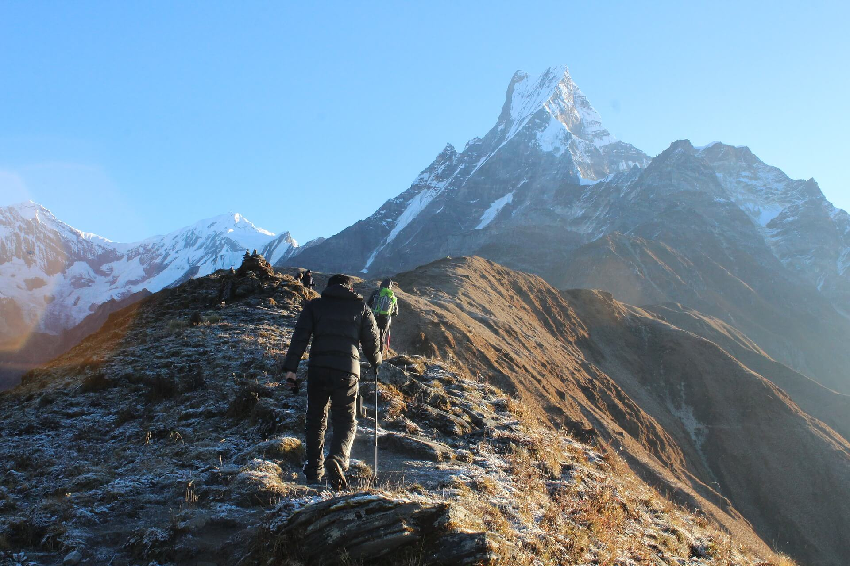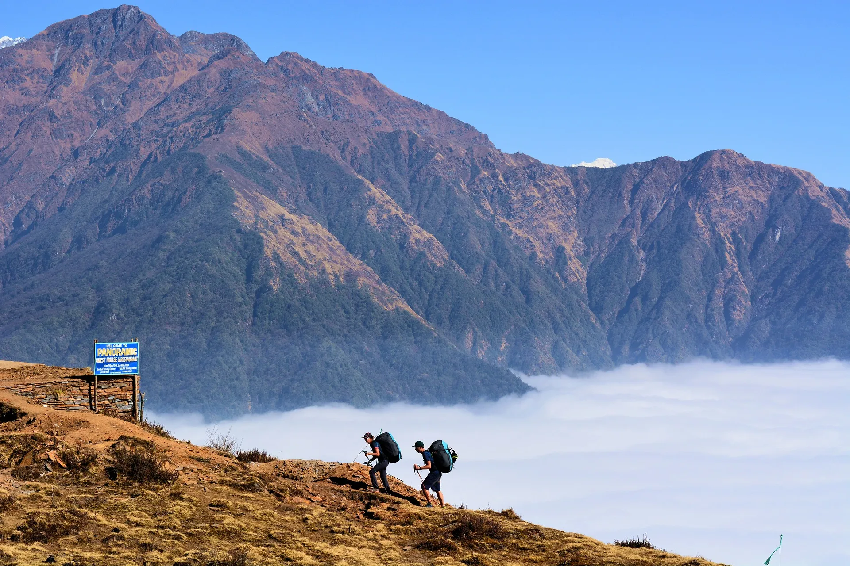Do you want to trek in Nepal and don’t know where to start? You are in the best place! In our Nepal trekking guide, we are going to give you all the information and advice you need for your next trip. We are going to tell you about the best season for trekking, equipment, food, accommodation, insurance, permits, what altitude sickness is and how it can be avoided, and many other topics about trekking in Nepal.
Best Time To Trek In Nepal

Although it is a year-round destination, the best weather conditions for trekking in Nepal are from March to June and from October to December. The months of June, July, and August are, without a doubt, the least recommended to travel to Nepal because it is the monsoon season.
If you are not cold, a good time can be from December to March, when the atmosphere is much more stable. However, there are regions that can be explored during the months of June, July, and August where the amount of rainfall is much lower.
Dolpa, Mustang, Humla, Mugu, and the northwestern part of Annapurna are regions belonging to the Tibetan Plateau of Nepal where the monsoons barely arrive, which favors trekking activity. One of the best-known treks that can be done in the monsoon season is the Annapurna circuit. In any case, before booking the flights, it is best to speak with specialized people so that they can offer you the best option according to your expectations.
The Water During The Trek
When we talk about trekking, water is one of the most important elements that must be taken into account. You can not miss it! For good hydration and acclimatization, I recommend you drink a lot of water, at least 3-4 liters a day. There are two ways to get water: buy it during the journey or use filters or water purification tablets. The second option is cheaper and less polluting. If you decide to purify the water with the tablets, it is advisable to buy Tang-type fruit powder, to change the flavor. After so many days it is appreciated.
Altitude Sickness
When you do a trekking route at such altitudes you could get to suffer from altitude sickness. As the altitude increases, the body has less oxygen than it needs and as a consequence, you can suffer from headaches, loss of appetite, dizziness, insomnia, vomiting, fatigue, etc. The main symptom is a headache and it usually manifests itself above 3,000m of altitude. The best recipe to prevent altitude sickness is to drink at least 4 liters of water a day, eat well and move slowly along the route. If symptoms persist, it is best to descend as soon as possible.
Food During The Trek
Food tends to be very itchy! It’s really good, but if you don’t want to test your stomach, make the words “No spicy” clear… In most places, you will have a wide variety to choose from. In all the tea houses there is a very varied menu with what you can eat.
The typical dish is dal-bhat, lentil soup (dal) with spices, accompanied by boiled rice (that), and sautéed vegetables, which will vary depending on the time of year and the area. Other typical dishes are momos and chow mien, which are rice noodles with vegetables. Both have Tibetan influence. Momos are balls of pasta filled with meat or vegetables that are steamed, fried, or in soup.
Apart from the typical dishes, there are pasta, pizza, potatoes, eggs, pancakes and for breakfast, porridge. I recommend you not to eat meat for two reasons: it is thick and sometimes due to the lack of infrastructure it could be expired.
Sleep During The Trek
As for accommodation along the trekking routes, Nepal has one of the best infrastructures in the world. “Tea houses”, tea houses as we call them in Spanish, there are even above 5,000 m of altitude. A good example is a penultimate village before reaching Everest Base Camp, Gorak Shep, which is at 5,170m.
As Nepal lives a lot from trekking tourism, the sector has developed quite a bit lately and offers a very wide range of accommodation depending on one’s budget. Most of the houses are basic but very clean and cozy. In general, the rooms are with 2 beds.
In the lower areas, the rooms have a private bathroom with hot water. Most tea houses have a hot shower that you pay for separately. There is also the possibility to charge your phone, camera, etc. in exchange for a few euros. Be careful, there is no toilet paper, you have to bring it! If we are talking about an ascent or expedition, the night is spent in a tent.
Guides And Porters
They are not required! Many times there is a doubt about hiring a guide or not. There are several reasons why we recommend bringing an experienced local guide. There are only advantages, for you and for the local economy. Do not forget that 80% of the population makes a living from tourism. The fact of being accompanied by an expert trekking guide will give more security and at the same time will provide more knowledge about the area. Going with a guide helps you interact with the local people and teaches you about their way of life.
If your backpack weighs more than approximately 8-10 kg, I also advise you to hire a porter. Most are of the Sherpa ethnic group who live in the mountains. They are strong people and live from this. Our advice is that, if you are not used to hiking over 3,000 meters, better take a local guide, they are not expensive. We offer trekking in Nepal with a local Spanish-speaking guide.
Trekking Insurance In Nepal. Is It Mandatory? No, But It Is Highly Recommended
If we talk about trekking in Nepal, we are talking about activity at altitude, in general, above 3000m, with which you are very exposed to altitude sickness. It is very important that the policy includes helicopter rescue. Taking into account the infrastructure of the country, if you are trekking, in case of an accident, the only viable option to get to the hospital is by helicopter. There are several companies that offer this service, such as Iati, Allianz, and Intermundial among others, etc.
Permit For Trekking And Ascent In Nepal
Yes, most trekking routes require a permit. If you go through a specialized agency they will take care of getting your permits. If you want to go on your own, you have to go to the TAAN (Trekking Agencies Association of Nepal) and NTB (Nepal Tourism Board) offices in Kathmandu or Pokhara.
Ramdung, Khongma, Naya Kanga, and Paldor Peak where you have to get permission. In spring the permit is more expensive than in autumn and winter.
Communication During The Trek
There are two ways to communicate with your loved ones during the trek. The first option is to buy a local SIM card once in Kathmandu. In Nepal, there are two mobile phone companies, NTC (Nepal Telecom) and Ncell, which have coverage along the most popular trekking routes, Annapurna, Everest, and Langtang.
The second option is to buy a card with a username and password to be able to connect to a WIFI network. Everest Link Card, for example, works only in the Everest area. It can be bought in the villages along the trek. Lately, as there is coverage, many accommodations have WIFI services that can be used at an additional extra cost.
You may like to read Visit Southern Norway In Six Days

